Effect of Tip Clearance on the Cavitation Flow in a Shunt Blade Inducer
Abstract
:1. Introduction
2. Structure and Main Parameters of a Shunt Blade Inducer
2.1. Main Parameters of a Pump and a Shunt Blade Inducer
2.2. The Test System
3. Analysis of the External Characteristics Test and the Numerical Calculation Results
4. Numerical Calculation Method
4.1. Computational Region and Verification of Grid Independence
4.2. Boundary Conditions
4.3. Turbulence Model
4.4. Cavitation Model
5. Prediction of the Cavitation Performance and Analysis of the Numerical Calculation Results
5.1. Cavitation Performance Curve of the Centrifugal Pump with the Shunt Blade Inducer under Different TCs
5.2. Tip Leakage Vortex in the Inducer with Different TCs under Small Flow Rate Conditions
5.3. Cavitation Evolution Process Diagram of Long and Short Blades near Rim Region
5.4. Load Distribution on the Inducer’s Blades at Different Blade Heights
5.5. Effect of TC on Load Distribution of the Long and Short Blades
5.6. Influence of Different Cavitation Numbers on Blade Load Distribution
6. Conclusions
- (1)
- TC has a certain effect on the critical cavitation coefficient. Under low flow rate conditions, when TC = 0.3 mm, the cavitation performance of a shunt blade inducer is the best, and the critical cavitation coefficient is 0.02.
- (2)
- The existence of the TC produces a significant leakage vortex at the inlet of the inducer, showing a strong transient effect. The tip leakage vortex in the inducer is mainly generated at the blades’ suction surfaces near the inlet. It gradually increases with the increase in TC. At the same time, the position of the leakage vortex at different phase angles of the inducer shifts, which indicates that the leakage vortex at the tip of the blade moves due to the rotation of the inducer, and the leakage vortex at the inlet of the blade tends to move toward the inlet of the inducer.
- (3)
- The position and degree of the blade tip leakage cavitation are explained. Cavitation mainly generates at the inlet of the long blade and at the suction side, which is close to the leakage vortex in the inducer. Under the same cavitation coefficient, when TC = 0.3 mm, the cavitation area is the smallest.
Author Contributions
Funding
Data Availability Statement
Conflicts of Interest
References
- Guo, X.; Zhu, Z.; Cui, B.; Shi, G. Effects of the number of inducer blades on the anti-cavitation characteristics and external performance of a centrifugal pump. J. Mech. Sci. Technol. 2016, 30, 3173–3181. [Google Scholar] [CrossRef]
- Guo, X.; Zhu, Z.; Cui, B.; Li, Y. Effects of the short blade locations on the anti-cavitation performance of the splitter-bladed inducer and the pump. Chin. J. Chem. Eng. 2015, 23, 1095–1101. [Google Scholar] [CrossRef]
- Guo, X.; Zhu, Z.; Cui, B.; Li, Y. The Rotating Cavitation Performance of a Centrifugal Pump with a Splitter-Bladed Inducer under Different Rotational Speed. Int. J. Turbo Jet-Engines 2015, 32, 275–283. [Google Scholar] [CrossRef]
- Guo, X.; Zhu, Z.; Cui, B.; Huang, Y. Anti-cavitation performance of a splitter-bladed inducer under different flow rates and different inlet pressures. Sci. China Technol. Sci. 2015, 58, 2131–2138. [Google Scholar] [CrossRef]
- Guo, X.; Yang, S.; Li, X.; Shi, L.; Hua, E.; Zhu, Z. The Tip Clearance Cavitation Mechanism of a High-Speed Centrifugal Pump with a Splitter-Bladed Inducer. Processes 2021, 9, 1576. [Google Scholar] [CrossRef]
- Shen, J.T.; Xu, F.Y.; Cheng, L.; Pan, W.F.; Ge, Y.; Li, J.X.; Zhang, J.L. Simulation of Internal Flow Characteristics of an Axial Flow Pump with Variable Tip Clearance. Water 2022, 14, 1652. [Google Scholar] [CrossRef]
- Wei, X.X.; Zhang, R.H. The axial tip clearance leakage analysis of the winglet and composite blade tip for the liquid-ring vacuum pump. Vacuum 2022, 200, 111027. [Google Scholar] [CrossRef]
- Yang, Y.; Zhou, L.; Bai, L.; Xu, H.; Lv, W.N.; Shi, W.D.; Wang, H.L. Numerical Investigation of Tip Clearance Effects on the Performance and Flow Pattern Within a Sewage Pump. J. Fluids Eng. 2022, 144, 081202. [Google Scholar] [CrossRef]
- Zheng, Y.H.; Li, Y.J.; Zhu, X.Y.; Sun, D.H.; Meng, F. Influence of asymmetric inflow on the transient pressure fluctuation characteristics of a vertical mixed-flow pump. Proc. Inst. Mech. Eng. Part A J. Power Energy 2022. [Google Scholar] [CrossRef]
- Qian, B.; Cai, Y.H.; Ding, Q.; Zhao, D.L.; Sun, W.P.; Wang, L.K. Investigation of Tip Leakage Vortex Structure and Trajectory in a Centrifugal Pump with a New Omega Vortex Identification Method. Appl. Sci. 2022, 12, 5270. [Google Scholar] [CrossRef]
- Shu, Z.K.; Shi, G.T.; Dan, Y.; Wang, B.X.; Tan, X. Enstrophy dissipation of the tip leakage vortex in a multiphase pump. Phys. Fluids 2022, 34, 033310. [Google Scholar] [CrossRef]
- Shen, X.; Zhang, D.S.; Xu, B.; Wu, H.R.; Wang, P.; Shi, W.D. Comparative study of tip leakage vortex trajectory and cavitation in an axial flow pump with various tip clearances. J. Mech. Sci. Technol. 2022, 36, 1289–1302. [Google Scholar] [CrossRef]
- Brennen, C.E. Cavitation and Bubble Dynamics; Cambridge University Press (CUP): New York, NY, USA, 2013; pp. 59–62. [Google Scholar] [CrossRef]
- Parikh, T.; Mansour, M.; Thévenin, D. Maximizing the performance of pump inducers using CFD-based multi-objective optimization. Struct. Multidiscip. Optim. 2021, 65, 9. [Google Scholar] [CrossRef]
- Xiang, L.; Tan, Y.; Chen, H.; Xu, K. Experimental investigation of cavitation instabilities in inducer with different tip clearances. Chin. J. Aeronaut. 2021, 34, 168–177. [Google Scholar] [CrossRef]
- Ke, S.U.; Wen-wu, S.; Jian-wei, S.; Yue, Z.; Qiang, D. The Effect of Tip Clearance on Flow Characteristics in Inducers. China Rural. Water Hydropower 2021, 136–140, 149. [Google Scholar]
- Karakas, E.S.; Watanabe, H.; Aureli, M.; Evrensel, C.A. Cavitation Performance of Constant and Variable Pitch Helical Inducers for Centrifugal Pumps: Effect of Inducer Tip Clearance. J. Fluids Eng. 2019, 142, 021211. [Google Scholar] [CrossRef]
- Kim, C.; Kim, S.; Choi, C.-H.; Baek, J. Effects of inducer tip clearance on the performance and flow characteristics of a pump in a turbopump. Proc. Inst. Mech. Eng. Part A J. Power Energy 2017, 231, 398–414. [Google Scholar] [CrossRef]
- Amezcua, R.C.; Khelladi, S.; Mazur-Czerwiec, Z.; Bakir, F.; Campos-Amezcua, A.; Rey, R. Numerical and experimental study of cavitating flow through an axial inducer considering tip clearance. Proc. Inst. Mech. Eng. Part A J. Power Energy 2013, 227, 858–868. [Google Scholar] [CrossRef]
- Kim, S.; Choi, C.; Kim, J.; Park, J.; Baek, J. Effects of tip clearance on performance and characteristics of backflow in a turbopump inducer. Proc. Inst. Mech. Eng. Part A J. Power Energy 2013, 227, 847–857. [Google Scholar] [CrossRef]
- Fu, Y.; Yuan, J.; Yuan, S.; Pace, G.; D’Agostino, L. Effect of Tip Clearance on the Internal Flow and Hydraulic Performance of a Three-Bladed Inducer. Int. J. Rotating Mach. 2017, 2017, 2329591. [Google Scholar] [CrossRef] [Green Version]
- Cheng, H.-Y.; Ji, B.; Long, X.-P.; Huai, W.-X.; Farhat, M. A review of cavitation in tip-leakage flow and its control. J. Hydrodyn. 2021, 33, 226–242. [Google Scholar] [CrossRef]
- Cheng, H.Y.; Bai, X.R.; Long, X.P.; Ji, B.; Peng, X.X.; Farhat, M. Large eddy simulation of the tip-leakage cavitating flow with an insight on how cavitation influences vorticity and turbulence. Appl. Math. Model. 2020, 77, 788–809. [Google Scholar] [CrossRef]
- Cheng, H.Y.; Long, X.P.; Ji, B.; Peng, X.X.; Farhat, M. Suppressing tip-leakage vortex cavitation by overhanging grooves. Exp. Fluids 2020, 61, 159. [Google Scholar] [CrossRef]
- ANSYS. ANSYS CFX-Solver Theory Guide, Release 18.0; ANSYS: Canonsburg, PA, USA, 2018. [Google Scholar]
- Cheng, X.; Zhang, A. Effect of axial matching between inducer and centrifugal pump suction chamber on cavitation performance. Proc. Inst. Mech. Eng. Part A J. Power Energy 2019, 234, 947–956. [Google Scholar] [CrossRef]



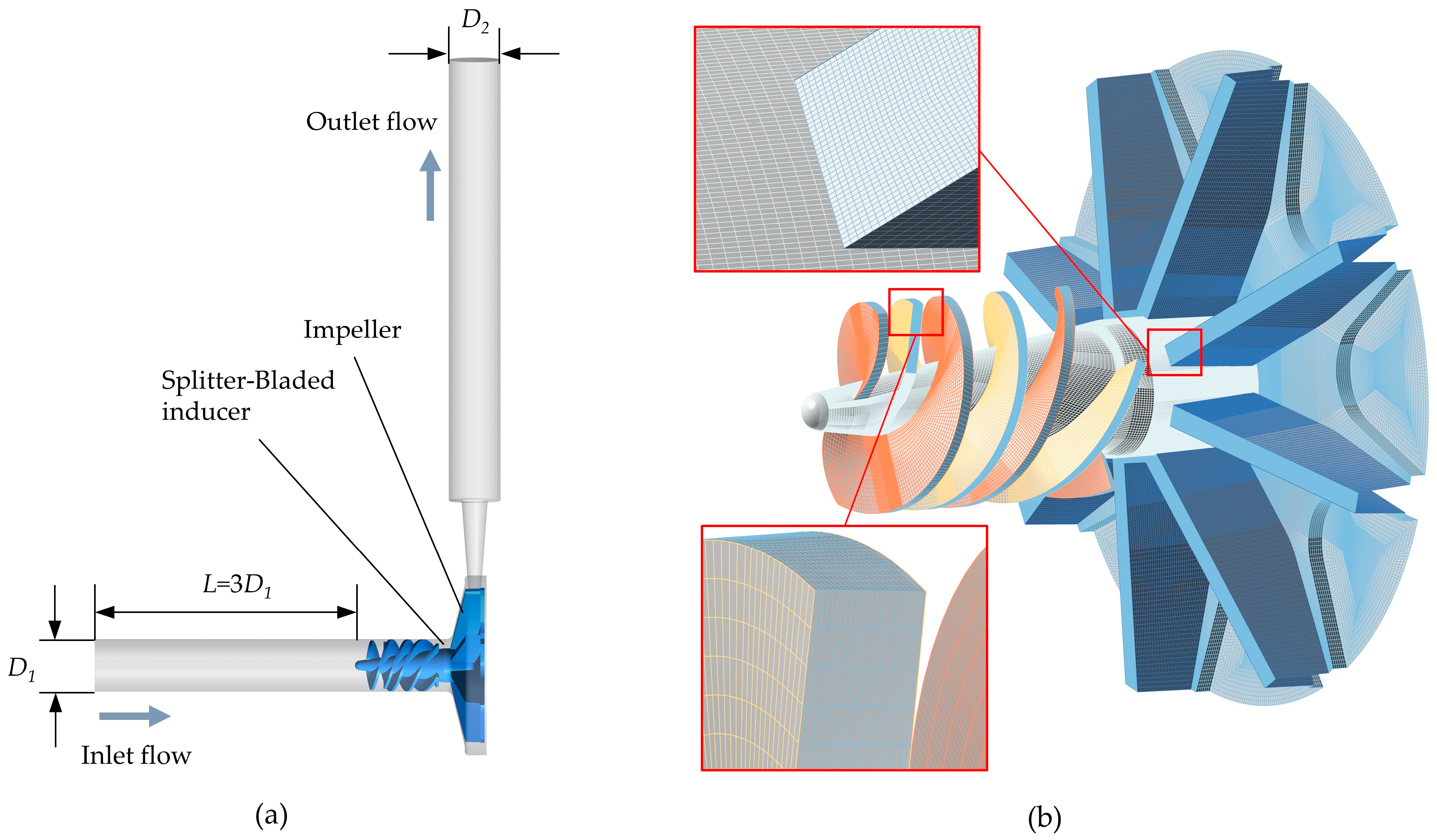
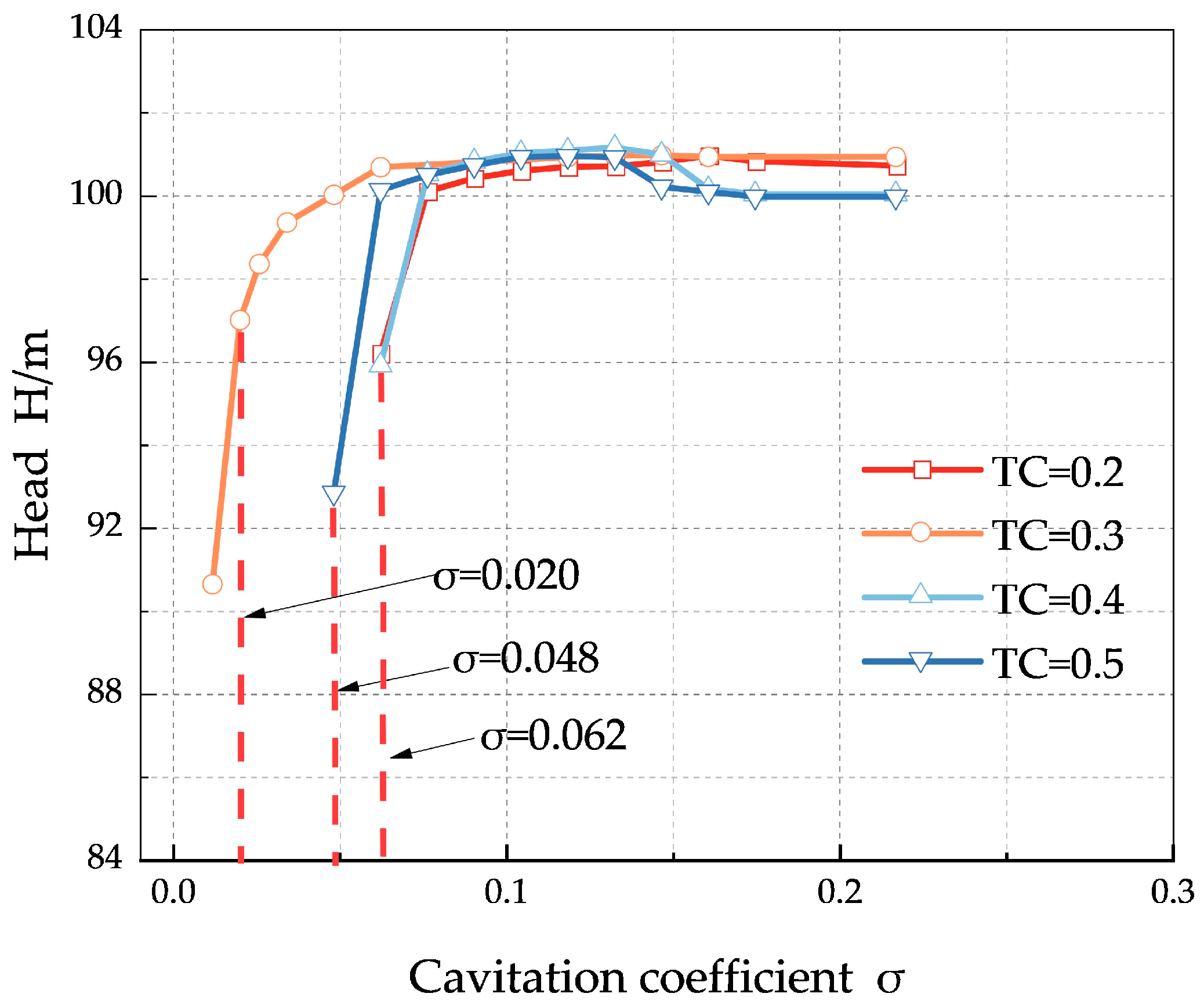
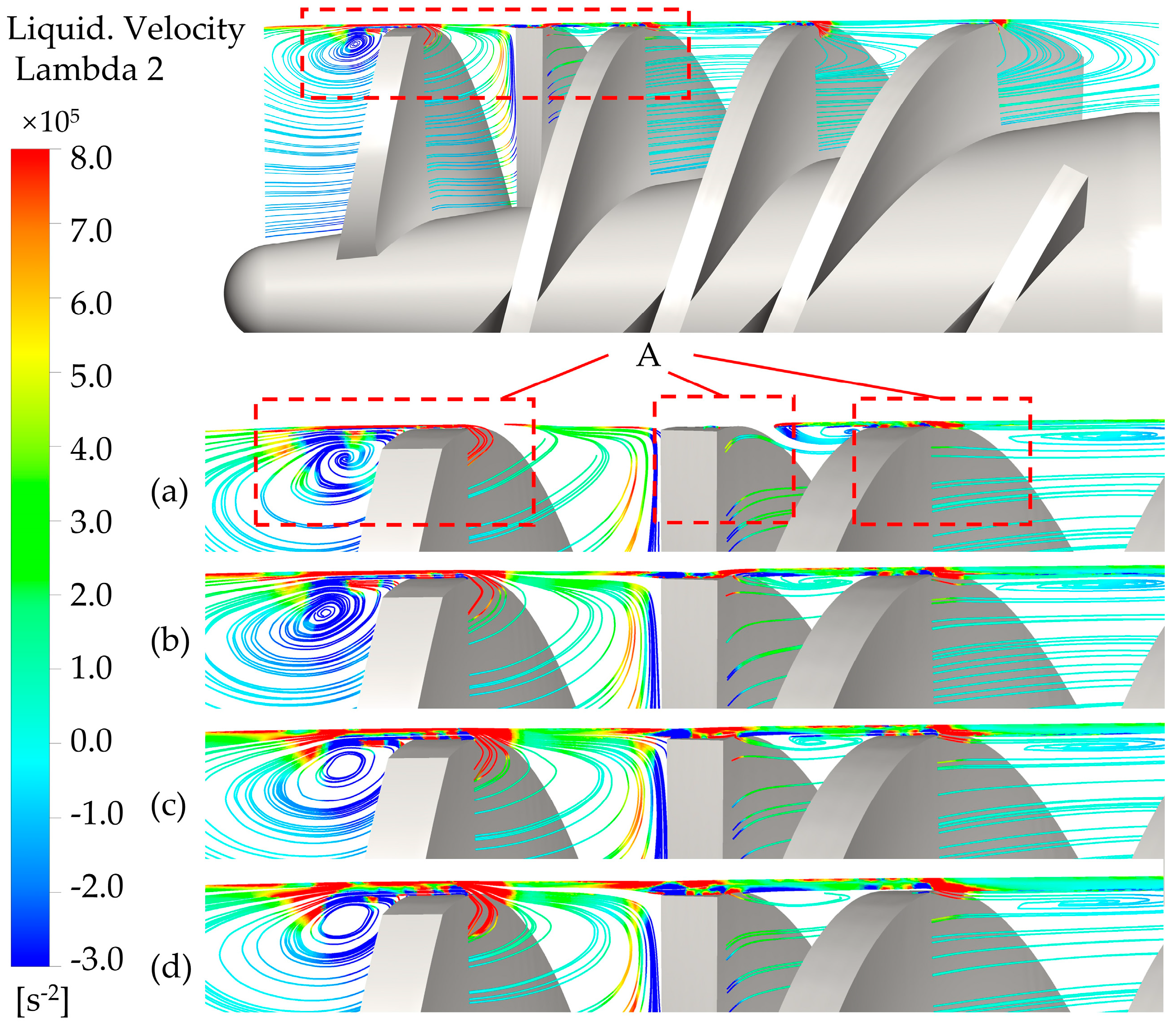
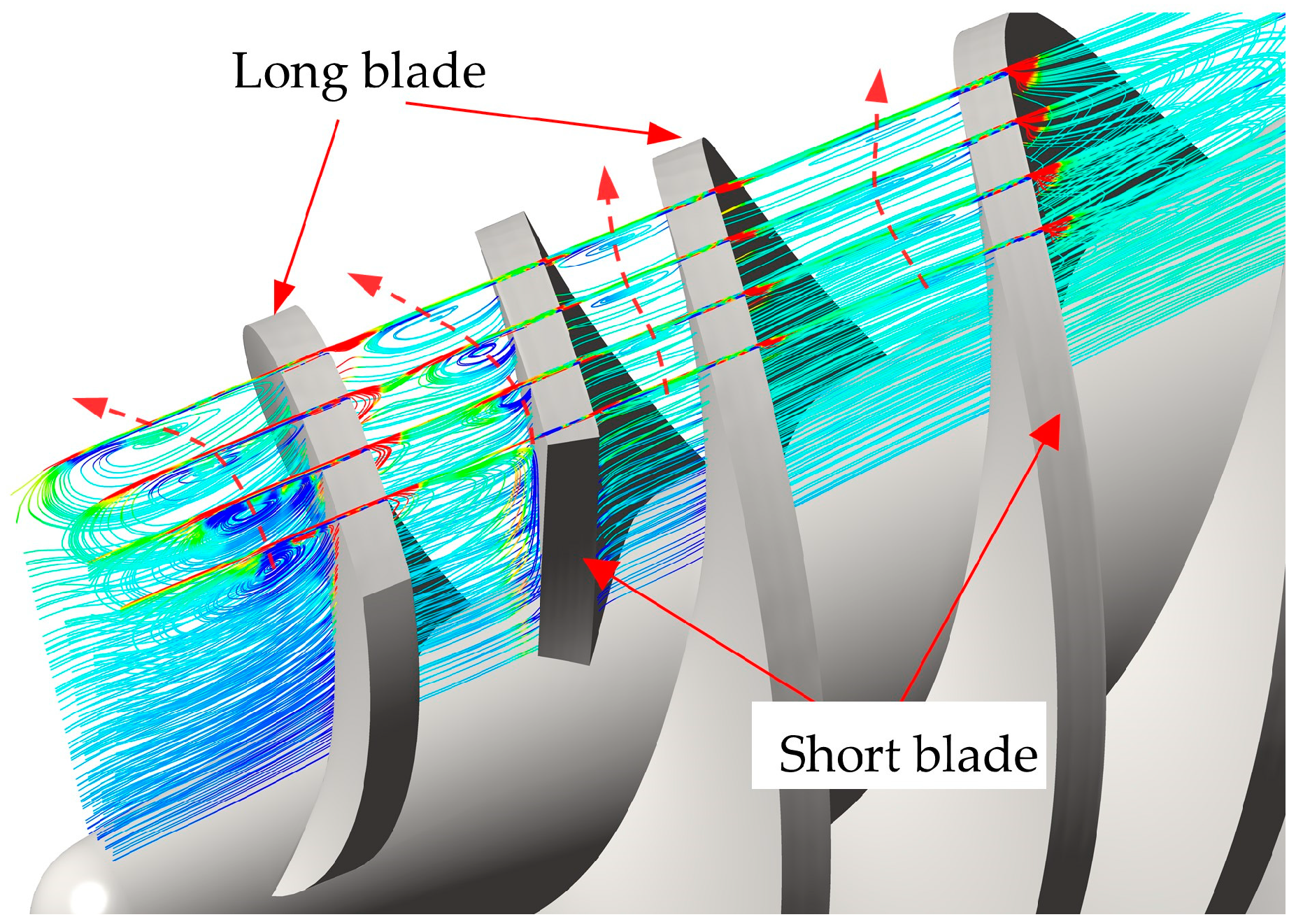



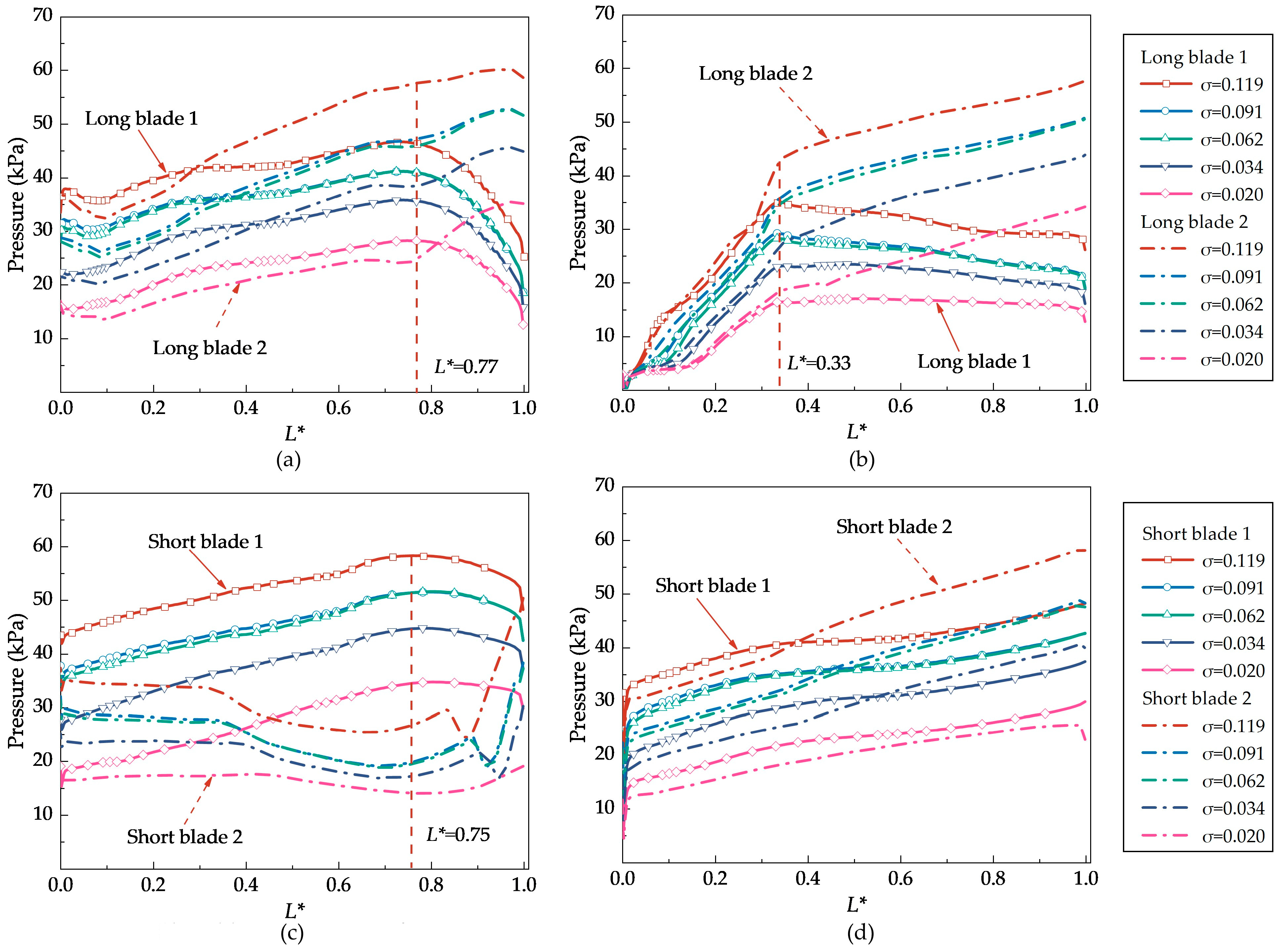
| Parameters | Value |
|---|---|
| Flow rate (Q, m3/h) | 4 |
| Head (H, m) | 100 |
| Rotation speed (n, r/min) | 6000 |
| Pipe diameter D1 (used to control TC, mm) | 38.4~39 |
| The biggest diameter of the inducer(mm) | 38 |
| Tip Clearance TC (mm) | Critical Cavitation Coefficient σ |
|---|---|
| 0.2 | 0.062 |
| 0.3 | 0.020 |
| 0.4 | 0.062 |
| 0.5 | 0.048 |
Publisher’s Note: MDPI stays neutral with regard to jurisdictional claims in published maps and institutional affiliations. |
© 2022 by the authors. Licensee MDPI, Basel, Switzerland. This article is an open access article distributed under the terms and conditions of the Creative Commons Attribution (CC BY) license (https://creativecommons.org/licenses/by/4.0/).
Share and Cite
Guo, X.; Jiang, C.; Qian, H.; Zhu, Z.; Zhou, C. Effect of Tip Clearance on the Cavitation Flow in a Shunt Blade Inducer. Energies 2022, 15, 6330. https://doi.org/10.3390/en15176330
Guo X, Jiang C, Qian H, Zhu Z, Zhou C. Effect of Tip Clearance on the Cavitation Flow in a Shunt Blade Inducer. Energies. 2022; 15(17):6330. https://doi.org/10.3390/en15176330
Chicago/Turabian StyleGuo, Xiaomei, Chongyang Jiang, Heng Qian, Zuchao Zhu, and Changquan Zhou. 2022. "Effect of Tip Clearance on the Cavitation Flow in a Shunt Blade Inducer" Energies 15, no. 17: 6330. https://doi.org/10.3390/en15176330
APA StyleGuo, X., Jiang, C., Qian, H., Zhu, Z., & Zhou, C. (2022). Effect of Tip Clearance on the Cavitation Flow in a Shunt Blade Inducer. Energies, 15(17), 6330. https://doi.org/10.3390/en15176330





